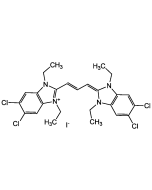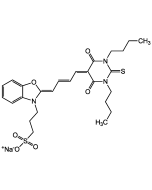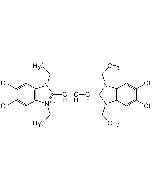Cookie Policy: This site uses cookies to improve your experience. You can find out more about our use of cookies in our Privacy Policy. By continuing to browse this site you agree to our use of cookies.
AdipoGen Life Sciences
JC-10 (high purity)

| Product Details | |
|---|---|
| Synonyms | Enhanced JC-1 |
| Product Type | Chemical |
| Properties | |
| Formula |
C25H29Cl2IN4 |
| MW | 583.3 |
| CAS | 5563-28-0 |
| Purity Chemicals | ≥98% (HPLC) |
| Appearance | Deep blue to violet solid. |
| Solubility | Soluble in DMSO (5mg/ml). Poor solubility in water (1µM). |
| Identity | Determined by 1H-NMR. |
| Other Product Data |
Application Protocols for JC-1: See literatures 1-3. Solubility: Due to the low solubility in water, we recommend preparing a JC-10 stock solution in DMSO (1mg/ml) which then can be further diluted in the aqueous buffer of choice. The DMSO stock solution of the compound is stable for at least 1 month when stored at -20°C. Avoid repeated freeze-thaw cycles which can damage the compound. Prepare the working solution on the day of use. The working solution can not be restored or frozen and should be used within one day. |
| InChi Key | WBMULJOQZAKELP-UHFFFAOYSA-M |
| Smiles | CCN(C1=CC=C(Cl)C=C1N/2CC)C2=C\C=C\C3=[N+](CC)C(C=CC(Cl)=C4)=C4N3CC.[I-] |
| Shipping and Handling | |
| Shipping | AMBIENT |
| Short Term Storage | +4°C |
| Long Term Storage | -20°C |
| Handling Advice |
Keep cool and dry. Protect from light. |
| Use/Stability | Stable for at least 2 years after receipt when stored at -20°C. |
| Documents | |
| MSDS |
 Download PDF Download PDF |
| Product Specification Sheet | |
| Datasheet |
 Download PDF Download PDF |
JC-10 is superior analog of JC-1, useful for determining mitochondrial membrane potential (MMP) in cells by flow cytometry, fluorescence microscopy and in microplate-based fluorescent assays. JC-10 is a cationic, lipophilic dye that accumulates in mitochondria of cells with a polarized mitochondrial membrane, selectively generating an orange J-aggregate emission profile (λex = 540 nm/λem = 590 nm) in healthy cells. Upon cell injury or cell death, as membrane potential decreases, which results in the failure to retain JC-10 aggregates in the mitochondria and JC-10 monomers are generated resulting in a shift to green emission (λex = 490 nm/λem = 525 nm). JC-10 shows improved solubility compared to JC-1 in aqueous media and an ability to detect subtler changes in mitochondrial membrane potential loss. JC-10 allows for qualitative visualization (shift from orange to green fluorescence) and quantitative detection (fluorescence intensity ratio) of mitochondrial membrane potential changes. Wavelength Maxima: λex = 510 nm | λem = 525 nm.
- Flow cytometric analysis of mitochondrial membrane potential using JC-1: A. Cossarizza & S. Salvioli; Curr. Protoc. Cytom. Chapter 9, Unit 9.14 (2001) (JC-1 Protocol)
- Polychromatic analysis of mitochondrial membrane potential using JC-1: E. Lugli, et al.; Curr. Protoc. Cytom. Chapter 7, Unit 7.32 (2007) (JC-1 Protocol)
- Labeling mitochondria with JC-1: B. Chazotte; Cold Spring Harb. Protoc. 2011, (2011) (JC-1 Protocol)
- Reactive oxygen species in unstimulated hemocytes of the pacific oyster Crassostrea gigas: A mitochondrial involvement: L. Donaghy, et al.; PLoS One 7, e46594 (2012)
- Improving anticancer efficacy of (-)-epigallocatechin-3-gallate gold nanoparticles in murine B16F10 melanoma cells: C.C. Chen, et al.; Drug Des. Dev. Ther. 8, 459 (2014)
- Calmodulin antagonists induce cell cycle arrest and apoptosis in vitro and inhibit tumor growth in vivo in human multiple myeloma: S. Yokokura, et al.; BMC Cancer 26, 882 (2014)
- Toxicology of ZnO and TiO2 nanoparticles on hepatocytes: impact on metabolism and bioenergetics: C. Filippi, et al.; Nanotoxicology 9, 126 (2015)
- Neurotoxicity of a pyrethroid pesticide deltamethrin is associated with the imbalance in proteolytic systems caused by mitophagy activation and proteasome inhibition: T. Hirano, et al.; Toxicol. Appl. Pharmacol. in press (2021)
- Chemically Defined Xeno- and Serum-Free Cell Culture Medium to Grow Human Adipose Stem Cells: S. Panella, et al.; Cells 10, 466 (2021)
- An adverse outcome pathway-based approach to assess the neurotoxicity by combined exposure to current-use pesticides: T. Hirano, et al.; Toxicology 500, 153687 (2023)













